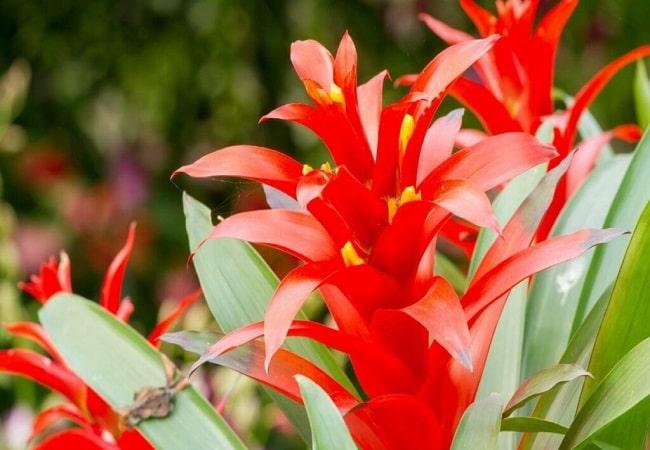Bromeliads care are a type of plant that is known for its vibrant colors and lush foliage. These plants come from tropical areas and do well in humid places. The plant is known for its brightly colored flowers and leaves.
But like any plant, they require some care and attention to stay healthy and thrive. Many species grow by adhering to a surface like a tree, although they can also be grown in a bark-like potting mix. Diseases and pests are uncommon. Debbie Neese, the Lively Root plant expert, says these bromeliads obtain everything they need from the environment. Flowers can last months and are beautiful and pleasant in winter.
In this blog post, I will tell you everything you need to know about caring for bromeliads. I will talk about how much water, light, and fertilizer you need. Keep reading to find out more!
Quick Navigation
The Basic Of Bromeliad Care Plant
| Scientific Name | Bromeliaceae |
| Common Name | Bromeliad |
| Native Area | South and Central America, the Caribbean, and West Africa |
| Family | Bromeliaceae, the pineapple family |
| Type Of Plant | Monocot flowering plants |
| Adult Size | One inch to 2 to 3 feet tall (Varies by genera and species) |
| Exposure To Sunlight | Bright, indirect light |
| Hardiness Zones | Zones 9 and 10 or 10-11 (USDA) |
| Preferable Fertilizer | Most bromeliads do not require fertilizer to thrive ( Use low-nitrogen 10-20-20 fertilizer or a balanced 20-20-20 fertilizer diluted to half strength.) |
| Soil Type | Fast-draining potting soil |
| Soil pH | ph 5.0 to 6.0 (acidic) |
| Water | They generally only need water 2-3 times a month. |
| Bloom Time | Months or even up to a year |
| Flower Color | Pink, Red, Orange, and Yellow |
| Pests & Diseases | Stem rot affects bromeliads commonly. They have fungus. Pythium’s roots wilt, blanch, and turn black and mushy |
| Toxicity | No bromeliad is poisonous to people, cats, dogs, or other indoor pets |
How To Care And Keep Your Bromeliad Plant Healthy
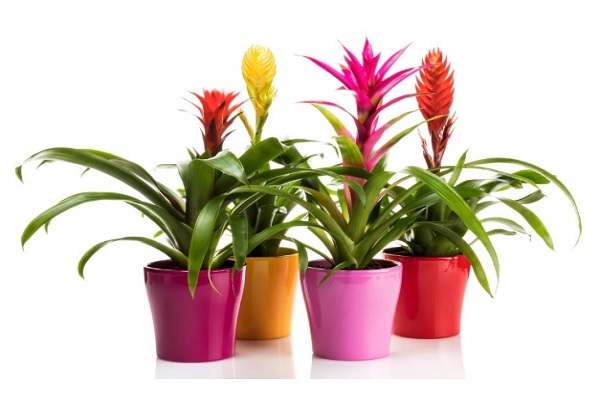
Bromeliad plants differ from care for most other plants; you will find out if you are new to growing these beautiful tropical plants. Bromeliads need special care when watering, feeding, and putting them in their pots. This is because their leaves absorb the water and nutrients they need.
When taking care of bromeliads, you should do a few important things to ensure your plant stays healthy and grows well.
Watering

You should not overwater your bromeliad plant, as too much moisture can cause the roots to rot. The best way to water a bromeliad is to soak the base of the plant in a bowl of water for about 15 minutes, once every week or two. Allow the excess water to drain before putting the plant back in its pot.
Light Requirement

There are many kinds of bromeliads, and each can handle different amounts of light. Some people can stand up to the intense heat of the tropical sun, but others will get burned very quickly. In general, plants with soft, flexible, and spineless leaves like lower light levels, while plants with stiff, hard, and spineless leaves like bright indirect light.
Plants that look yellowish may get too much light, while dark green or long plants may not get enough. It’s possible that giving the plant more light would help it bloom, as long as all the other conditions are good.
Best Potting Mix For Bromeliad
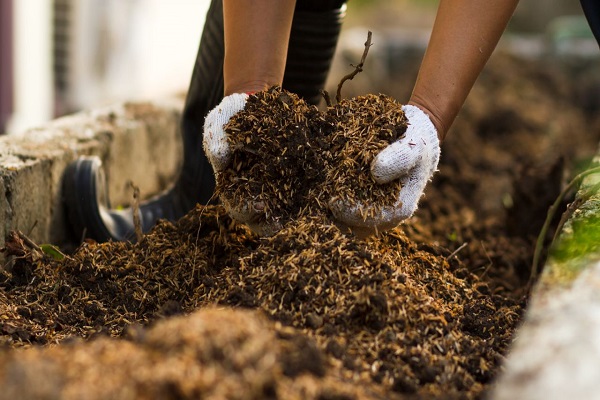
Bromeliads don’t technically need to be planted in soil at all. They don’t get water or food from the soil. Instead, their roots only help them hold on to trees, other plants, or other things that help them grow in the wild.
Bromeliads are grown in a pot or mounted on logs, wood, or rocks. If you want to grow bromeliads in pots, you can buy soil mix for bromeliads or use soil mix for orchids.
You can make your own if you don’t want to buy bromeliad soil. The best homemade potting mix for bromeliads would be a soilless mix with sphagnum moss, bark, perlite, and other coarse organic materials that drains quickly and doesn’t need soil.
If you’re planting bromeliads in regular potting soil, ensure the soil stays dry, or the plant could die.
Fertilizer For Bromeliad
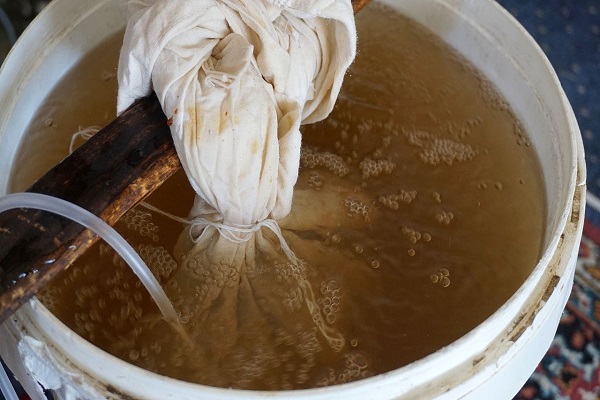
Bromeliads can reproduce independently without the requirement for fertilization. Since they are naturally slow-growing plants, applying fertilizer won’t have much of an impact on their growth.
However, bromeliads will flourish with the addition of a few nutrients, just like any other plant; the trick is to utilize fertilizer properly.
It would help if you made it a point to exclusively use natural organic liquid fertilizer since bromeliads are particularly susceptible to the effects of chemical plant fertilizers.
If you wish to fertilize your bromeliads, you should do it in the spring and summer using a liquid organic houseplant fertilizer diluted to half strength (use low-nitrogen 10-20-20 fertilizer or a balanced 20-20-20 fertilizer). You can also use compost tea. Throughout the winter, it is preferable to avoid fertilizing bromeliads.
Temperature And Humidity
Bromeliads can grow in various temperatures, but most species need to be kept warm in the winter. Suppose you want to add these plants to your yard but live where winter temperatures often drop below freezing. In that case, you might want to plant bromeliads in containers
brought inside during the colder months. Temperatures between 60 and 85 degrees Fahrenheit are best for bromeliads. Even though there are varieties that can survive temperatures as low as 20 degrees, You shouldn’t put them in places where the temperature is less than 40 degrees.
They do well in places where the humidity is about 60%. In many parts of the world, the best time to bring bromeliads outside is in the summer. It would help to remember that bromeliads grow on the damp, dark floors of tropical forests or trees. Try to give your plants the same conditions that helped those plants grow.
Pruning
Bromeliad plants don’t need to be pruned very often. You can cut off dead or dying leaves at any time.
After the flower spike dies back, cut it off, but let the plant grow as long as possible, so it has time to make pups.
Once the main plant dies, you can cut it down and leave the pups to grow in the pot. You can take the pups off if the mother plant is dead and put them in their pots.
Most Common Problem You Can Face
Nothing is worse than observing your bromeliad plant die while you are unsure of the cause. I’ll thus outline some of the most typical issues in this area and provide you with solutions.
Bromelia Flower Turning Brown Or Losing Color

When the flower bract, which most people call the flower, starts to turn brown or lose its color, it means that the plant has finished blooming and is starting to die, which is a normal part of a bromeliad’s life cycle.
Once the plant starts to die, there is nothing you can do to save it. But before you throw it away, look around the plant’s base to see if any bromeliad pups are growing.
If so, you probably have a lot of other plants to replace the one that is dying. Leave the pups to grow, and cut the mother plant down once it has died completely.
The Flower Produces Small, Hairlike Blossoms
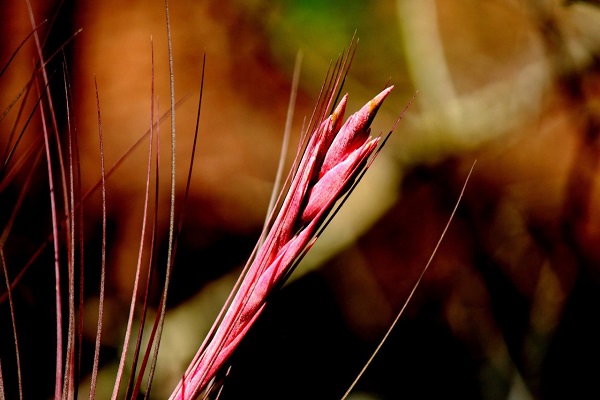
This is the blossom! The floral bract, not the actual flower, is what most people mean when they talk about the flower of a bromeliad.
If you’ve never seen a bromeliad flower before, you might not be ready for how strange some of them look when they start to open. There are a lot of different shapes, sizes, and colors of bromeliad flowers.
The Leaves Of My Bromeliad Turning Yellow
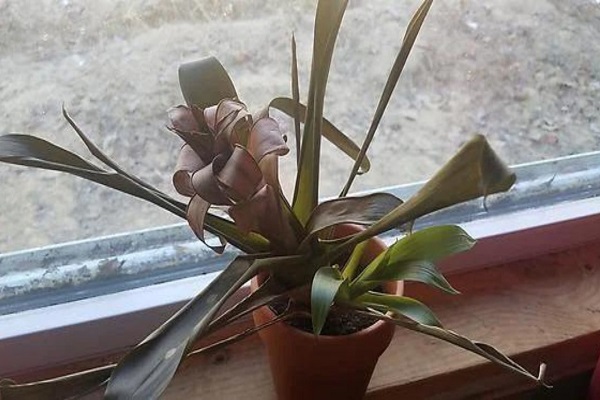
If you notice the leaves of your bromeliad turning yellow, don’t worry – it’s perfectly normal! There are a few reasons why this could happen, and you don’t need to worry most of the time.
- One reason for yellowing leaves is that the plant is simply getting older. As bromeliads age, their leaves will naturally turn yellow and eventually die off. If this is the case, you can remove the yellow leaves as they appear.
- Another reason for yellowing leaves is that the plant is not getting enough light. Bromeliads need bright, indirect light to thrive – if they’re not getting enough light, their leaves will start to turn yellow. If so, try moving your plant somewhere with more light.
- Lastly, too much water can cause the leaves to turn yellow.
The Leaves On My Bromeliad Brown, Dry, And Crispy
If you have a bromeliad that suddenly has brown, dry, and crispy leaves, don’t panic! This is quite common, and there are several reasons why it happens.
- First, it could be due to too much sun exposure. Bromeliads are native to tropical regions and need filtered sunlight to thrive. If your plant is in direct sunlight for too long, the leaves will start to turn brown and crisp.
- Second, it could be due to too little water. Bromeliads are drought-tolerant plants, but they still need to be watered regularly. If the soil is allowed to dry out completely, the leaves will start to turn brown and crisp.
- Third, it could be due to a lack of nutrients. Bromeliads are heavy feeders and need a lot of nutrients to stay healthy.
Pests And Diseases

Insects are generally not a problem for bromeliads, but mealybugs and houseplant scales can be. As a result, you should always be on the lookout for these pests when giving your bromeliad plant its regular care.
An extremely effective technique to eliminate these bothersome insects that wreak havoc on houseplants is to use organic neem oil, a natural insecticide. Other options that work well include organic insecticidal soap and horticultural oil.
You can also use a cotton swab dipped in rubbing alcohol to remove mealybugs and houseplant scales from the plant. This will instantly kill the insects, and you’ll be able to get rid of them from the plant.
Never use chemical pesticides on pests that attack houseplants because they can become resistant to them, and the pest problem will worsen. Chemical insecticides might harm your bromeliad plant as well.
Most Commonly Asked Questions
Do All Bromeliads Only Bloom Once?
No, not all bromeliads only bloom once. Bromeliad species, such as the Aechmea fasciata, can bloom multiple times. The frequency with which a bromeliad bloom depends on the individual plant and its growing conditions. Generally, bromeliads that are grown in optimal conditions will bloom more often than those that are not.
How Do You Know When A Bromeliad Needs Water?
Bromeliads are tropical plants that are often found in rainforests. They are known for their beautiful flowers and colorful leaves. Bromeliads need a lot of water to thrive, but they also need good drainage. When watering a bromeliad, be sure to water the plant thoroughly, allowing the water to run through the pot and out the drainage holes. Be sure to empty any water that collects in the saucer beneath the pot.
How Long Does A Bromeliad Live?
Bromeliads are a plant that generally has a lifespan of around 2 to 3 years. However, some species of bromeliad can live for up to ten years. The specific lifespan of a bromeliad will depend on the individual plant’s species and growing conditions.
Do Bromeliads Come Back Every Year?
Bromeliads are a type of plant that typically bloom once and then die. However, some species of bromeliad can bloom multiple times. A bromeliad can bloom again if the conditions are right, but it is not guaranteed.
What Does A Dying Bromeliad Look Like?
Bromeliads are plants that usually only bloom once and then die. On the other hand, some species of bromeliad can bloom more than once. If the conditions are right, a bromeliad can bloom again. The blooms can last for months or even a year if the conditions are right. Bromeliads bloom and grow all year. Bromeliads are grown all the time.
Final Touch
The care of bromeliads is an essential aspect of ensuring their growth and vitality, making it crucial for plant enthusiasts and gardeners to familiarize themselves with these tropical plants’ unique needs. With their wide range of species and captivating aesthetics, bromeliads can enrich any indoor or outdoor space. Appropriate care encompasses various factors, including proper lighting, watering, temperature, humidity, and fertilization.
By closely adhering to these guidelines, gardeners can nurture healthy and vibrant bromeliads that will thrive and provide enjoyment for years to come. Overall, the care of bromeliads is a rewarding endeavor, allowing individuals to connect with nature and experience the satisfaction of cultivating these exotic and striking plants.

I’m Md. Mahfuz Anam always enjoys taking care of plants and gardening. I find it therapeutic and a great way to relax. I have also always been interested in learning about different types of plants and how to care for them.

